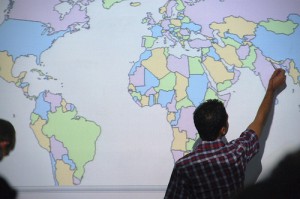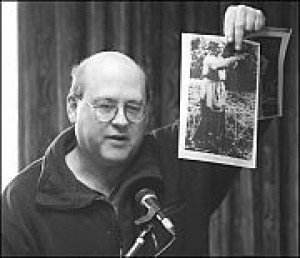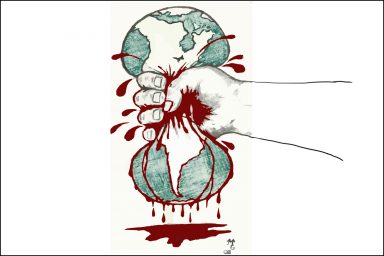 Anyone who still wonders why the Bush administration invaded Iraq would do well to become familiar with an institution whose existence few Americans are aware of: the American University of Iraq-Sulaimaniya.
Located in Kurdistan, at the nexus of northern Iraq's border with Iran and Turkey, AUI-S opened its doors in 2007. At the time, Thomas Friedman of the New York Times wrote about it with the sort of wide-eyed enthusiasm that had generally accompanied the invasion itself four years before. "Imagine for a moment if one outcome of the U.S. invasion of Iraq had been the creation of an American University of Iraq...Imagine if we had created an island of decency in Iraq...Well, stop imagining."
[Read the rest]
Anyone who still wonders why the Bush administration invaded Iraq would do well to become familiar with an institution whose existence few Americans are aware of: the American University of Iraq-Sulaimaniya.
Located in Kurdistan, at the nexus of northern Iraq's border with Iran and Turkey, AUI-S opened its doors in 2007. At the time, Thomas Friedman of the New York Times wrote about it with the sort of wide-eyed enthusiasm that had generally accompanied the invasion itself four years before. "Imagine for a moment if one outcome of the U.S. invasion of Iraq had been the creation of an American University of Iraq...Imagine if we had created an island of decency in Iraq...Well, stop imagining."
[Read the rest]
A website created by a self-described whistleblower and AUI-S employee inviting members of the AUI-S community to anonymously post their complaints reflects anger on all sides. “The school is being run by people with no experience running a successful school…” writes one person on the site, AUI-S Watch. “We raised awareness of discrimination of Iraqi employees,” writes another, “Yes, we have embarked on a campaign to criticize administrative staff with the aim to expose what we think are questionable management practices. Yes, we have attacked the complete lack of transparency at AUI-S and injustice it harbors.”
Agresto responded to the blog in a letter to AUI-S staff in which he described the reactions to AUI-S Watch that he had received from faculty members: “One said he felt sick when he read it. Another called it ‘twisted’ and said ‘It’s evil, pure and simple.’ Another wrote to Lara, Josh, and me to repeat the simple truth – ‘the cowardly writer of the blog does not represent our views, nor does this person represent the vast majority of the faculty.’ ”
The hostility between the parties was palpable. Meanwhile, former AUI-S professor Dolan has provided a more detailed picture in an Alternet piece titled. “I Was a Professor at the Horribly Corrupt American University of Iraq…Until the Neocons Fired Me.” (Dolan was fired in the summer of 2010–he says Agresto had discovered a satirical article Dolan had written years earlier, critical of neo-conservative figures in American politics, many of whom are personal friends of Agresto.)
Dolan portrays an atmosphere of venality, misogyny, anti-Semitism and incompetence, with John Agresto and Joshua Mitchell at the center. He describes Mitchell running around with wads of “taxpayer cash” to pay expenses, including $5,000 each to incoming US teachers “to help [us] settle in.” Dolan writes about the faculty in withering terms: “There was a clear, simple formula for success at AUI-S: be a Southern white male Republican with a talent for flattery, an undistinguished academic record and very little experience in university-level teaching. Some of the faculty were so dismally unqualified and shameless that even our students…saw through them.”
Dolan’s charges become more serious when he describes Dean of Student Affairs Denise Natali’s response to an ESL teacher being raped. “I see women walking around here in sleeveless t-shirts! Tank tops! What do you expect?” Natali herself received a death threat after expelling several students for missing too many classes. (Attempts to interview Natali, who left AUIS around the end of 2010, were not successful). Dolan also describes a male fundamentalist Christian professor calling a female colleague a “fucking whore” and AUI-S Personnel Director, Lara Dizeyee telling new faculty members (presumably as a practical matter in a Muslim country), “If you’re Jewish—keep it to yourself.” Diziyee, who has also departed AUIS, could not be reached for comment.
Meanwhile, AUI-S’s website keeps up appearances. Press on the “In the News” prompt and one finds a Commentary magazine article written by neoconservative Abe Greenwald. In “An Extraordinary American Achievement,” Greenwald enthuses about visiting the American University of Iraq with fellow neocon and ex-Middle East CIA specialist Reuel Gerecht. “It would be nice if the ‘books not bombs’ crowd took notice of the educational miracle birthed by Americans in the heart of the Muslim world,” he writes. “Everyone should visit the university’s website and look around. What you’ll find is as well suited to the term ‘shock and awe’ as any bombing campaign, and even more determinative.”
WHAT’S OIL THIS ABOUT?
Certain Kurds share that zeal about the university. They’re a particularly privileged group, who pushed heavily for the invasion in the first place and have done very well for themselves in the years since. They have a stake in a long-term US presence in Kurdistan—as a protective force both against their Sunni and Shiite fellow Iraqis to the South, and against the Iranians just next door. They also need a viable oil industry and the kind of workforce a university like AUI-S can potentially provide.
Kanan Makiya, a leading neocon and high-profile advocate of the 2003 invasion who sits on the AUI-S board, told WhoWhatWhy that the idea for the university began with Barham Salih, prime minister of the Kurdistan region, which is semi-autonomous from Baghdad. Salih, who is chairman of the AUI-S board of trustees, ran the Kurdish lobbying effort in Washington since shortly after the first Gulf War, and was, like Makiya, a key figure in pushing for the ouster of Saddam.
The Kurds associated with AUI-S seem to have huge amounts of money at their disposal. Salih raised $55 million for the university in 2009, purportedly through private sources, who have not been named. And Salih has promised an additional $100 million, mainly to fund the construction of the new campus. Jalal Talabani, President of Iraq, another AUI-S board member, reportedly personally donated $65 million (where that money came from is uncertain.)
In this part of the world, when such sums are involved, oil is almost always in the picture. The same year AUI-S was founded, the Kurdistan regional government signed a $700 million contract dubbed “Kurdistan Gas City,” with oil and gas affiliates Dana Gas and Crescent Petroleum, both based in the United Arab Emirates. The oil contract the companies signed with Dr. Salih—an oil engineer who became fabulously wealthy—is, according to Crescent’s website, “the largest private-sector investment currently being undertaken in Iraq.”



